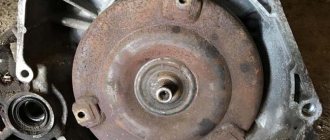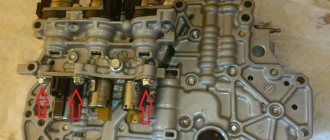Changing transmission oils in various cars is a mandatory procedure to ensure full performance, especially those equipped with automatic transmissions. Some car manufacturers claim that in certain models, in particular in the Volkswagen Passat B5 automatic transmission, it is in principle not necessary to change the oil, since it has enough resources for its entire service life.
However, depending on the conditions, the nature of the drive and other circumstances, you still have to change the oil, and due to the difficulties, only every 10 car owners know how to do it themselves.
When to change
Many drivers mistakenly believe that it is not necessary. Actually this is not true. After 80 thousand kilometers, this procedure must be carried out. They don’t want to change the lubricant mainly because this service costs a hefty sum at any car service center. But you can change the oil in a Volkswagen Passat B6 automatic transmission yourself, without the help of a specialist. The timing of the procedure is determined by the following reasons:
- appearance of noise;
- heavy gear shifting;
- deterioration of the vehicle's dynamic performance.
All these situations indicate problems with the automatic transmission. In most cases, it is enough to replace the old product with a new one. Since metal shavings appear in lubricants that have been used for a long time due to the friction of transmission parts. These chips significantly accelerate the wear process of other components. You can determine the quality of the oil used using a dipstick and a simple white rag. To do this, run this rag along the dipstick. If small black particles remain on it, then it’s time to change the lubricant.
Removing the pan, filter
Next, we will carefully describe the sequence of actions. Work begins with all additional parts being removed from the door, the car being driven into the inspection hole, immobilized when using wheel chocks, and the protection for access to the transmission pan is removed.
It has a drain plug, which must be unscrewed, having previously placed a container under it to collect water.
Only part of the oil will flow through the drain plug, so it makes no sense to remove the container too far.
When using an 8 hexagon, the mounting bolts
pallet and it is removed. On the inside of the pallet there are magnets, the purpose of which is to catch iron wear and tear. Of course, the amount of iron shavings can be used to partially estimate the degree of gearbox wear. If there are a lot of shavings, then the box is quite worn out, and serious damage is likely soon. The tray should be thoroughly washed.
Similar news
What oil to use
Despite the fact that car manufacturers claim that there is no need to change the oil in automatic transmissions, it must be done. This is said not only by experienced drivers, but also by factories that produce transmissions. As a rule, the recommended amount of product for a specific automatic transmission is indicated on the dipstick. But it is not at all necessary to adhere to this recommendation. The modern market is represented by several proven manufacturers. They all produce quality products. Here is a list of the most common ones in the VW Passat B5:
- Liqui Moly;
- Castrol;
- Lukoil;
- Mobil.
This is not a complete list. But drivers use oils from these manufacturers most often. If you have no desire to purchase these particular products, then pay attention to the presence of certificates and GOST standards from little-known brands. If there are none, then it is best to refrain from purchasing such funds.
Checking the gearbox oil level
To prepare for the shift, you need to measure the oil level in the Volkswagen Passat B5 automatic transmission. This can be done easily by following the step-by-step instructions:
- Place the car on a flat surface with a hole underneath;
- remove the engine protection;
- set the automatic transmission lever to position “P” and raise the handbrake;
- turn on the engine so that it idles;
- Remove the plug from the oil pan and check the level with a dipstick.
If it turns out that the lubricant level is below the minimum, be sure to add the required amount. As a rule, 6 liters are enough for full normal operation. You can slightly increase the volume of oil for the Volkswagen Passat B5 automatic transmission, but do not overdo it, as excess will also worsen the situation.
Removing the pan, filter
Next, we describe in detail the sequence of actions. Work begins with the car being driven into the inspection hole, immobilized with the help of wheel chocks, and the protection is removed to gain access to the transmission pan.
It has a drain plug that needs to be unscrewed after placing a container under it to collect the liquid.
Only part of the oil will drain through the drain plug, so you should not remove the container too far.
Using a 8mm hex, unscrew the bolts securing the pan and remove it. On the inside of the tray there are magnets whose task is to catch metal wear products. The amount of metal shavings can be used to partially assess the degree of gearbox wear. If there are a lot of chips, then the box is worn out quite badly, and serious damage is possible in the near future. The tray should be washed thoroughly.
All connectors of the wires approaching the control plate are also disconnected, after which the wire harness is released from its fixation and moved to the side.
You should immediately remember the position of the gearbox selector link; during assembly it will need to be installed, as before removal.
Tools and accessories
To drive a Volkswagen Passat yourself, you will need to prepare the following set of tools in advance:
- a set of keys and screwdrivers;
- two containers for liquid with a volume of at least 7 liters;
- a hose with a diameter of 20 millimeters and a funnel.
Also, if there is no hole for inspection, a jack will be useful. Use it with maximum safety precautions. Also, for a comfortable change of product, it is recommended to either drive 5–10 kilometers, or leave the engine running and idle for 10–15 minutes.
Topping up oil
In order to add lubricant to the normal level in the Volkswagen Passat B5 automatic transmission, we will need all the tools listed above. If you find a shortage using the dipstick, then follow these steps:
- Remove the lower engine protection.
- Remove the oil pan.
- Using the dipstick, determine how much oil needs to be added.
- Add new product to the automatic transmission using a hose and funnel.
As you can see, in a few steps you can easily add oil to the automatic transmission. The process will not cause difficulties even for an inexperienced driver.
What lubricant is relevant for the Passat B5 and what is needed for replacement
Before you start directly changing the oil, you must immediately prepare everything that may be needed during the process:
- A basin or tank for draining waste.
- Hex keys from No. 8 to No. 17.
- Thin tweezers.
- Set of torx bits from No. 25 to No. 30.
- To fill the oil you will need a thin soft hose.
- Torque wrench.
- A little gasoline.
- Rags.
- Pan gasket.
- Automatic transmission filter.
- And of course, the oil itself.
It’s worth saying right away that all of the above is necessary solely to replace the lubricant. Additionally, other accessories may be required, for example a set of keys for removing the pallet protection, etc.
Therefore, if you approach such an important event on your own, then only in a room with a full set of tools and an inspection hole.
Regarding the lubricant product itself, it is strongly recommended to use original oils corresponding to G 052162A2 for automatic Passat gearboxes.
In cases where it is not possible to find the original, the use of other lubricants in the form of ESSO 71141 or MOBIL LT 71141 is allowed.
The total volume of production is 9 liters + - and even if a little oil remains even during the replacement, you can remove it and add it at the next replacement.
1.19. Checking/replacing the oil level in the automatic transmission
The transmission oil level in an automatic transmission depends on the temperature of the transmission oil.
Since accurate temperature measurement requires diagnostic equipment, it is recommended that this work be carried out at a VW service station. Typically, the oil level in an automatic transmission remains constant if no leaks are visually visible. In this case, there is no need to check the oil level. Automatic 4-speed gearbox 01N (in combination with 4-cylinder engine, except for 150 HP engines)
When checking the oil level and changing the oil, you must wear safety glasses. You will also need to install a new screw plug seal and a new plug safety cap.
Checking the oil level
When checking the level, the temperature of the transmission oil should be slightly below +35° C. This temperature is reached a short time after starting the engine. To determine the temperature, it is necessary to connect VW diagnostic equipment to the connector. Otherwise, the temperature can only be determined approximately.
| EXECUTION ORDER | ||||
Change of oil
|
Results
To summarize, we can safely say that changing the oil in an automatic transmission is a mandatory procedure. It is done quite simply with your own hands. Regularly changing the lubricant will help keep transmission parts in working condition, eliminate noise, and increase smooth control.
Checking/changing the oil level in an automatic transmission
Diagnostics of the oil level in an automatic transmission 1 – threaded plug, 2 – bypass (drain) pipe in the oil pan, 3 – plug (plug), 4 – safety cap
The transmission oil level in the automatic transmission of a Volkswagen Passat depends on the temperature of the transmission oil. Because diagnostic equipment is useful for accurately measuring temperature, it is suggested that this work be done at a Vw service station. Typically, the oil level in an automatic transmission remains unchanged if leaks are not visually visible. In this case, there is no need to check the oil level.
Automatic 4-speed gearbox 01n (coupled with a 4-cylinder engine, except for engines with a power of 150 hp.
Volkswagen Passat automatic transmission manual
The level of transmission fluid in a Volkswagen Passat automatic transmission can change at different ambient temperatures. To accurately determine the level, you must have special equipment. Often the ATF level in the transmission remains unchanged, especially if there are no leaks. If everything is visually in order, then there is no need to check the oil level.
The Volkswagen Passat is equipped with a 01N gearbox with four speeds (combined with a four-cylinder engine producing 150 hp). Automatic transmission oil Volkswagen Passat B5 – ATF G052162A2 (oil volume filled 5.75 l), automatic transmission filter 01V 325 429, crankcase gasket 01V 321 371, filter o-ring 01V 325 443.
It is better to wear special glasses that will protect against possible oil splashes while checking the level. Next, you need to install new sealing plugs, as well as a protective cap.
Volkswagen Passat automatic transmission diagram
Assembly
Later, the slab is assembled back, with all this being strictly observed in the installation of all small parts in place.
Next comes the assembly. First, the control plate is installed to the area and secured with bolts. The force with which the fastening bolts
are tightened - 8 Nm. The sequence of tightening the bolts is from number 1 to number 17. During the installation process, it is important to ensure that the selector link is in its proper place.
The next step is connecting the wiring and fixing it.
All that remains is to place the new filter and the pan itself at its destination, having previously replaced its gasket. It is better to immediately change the gasket on the drain plug.
Oil level diagnostics
Make sure that the oil temperature is no more than +35°C.
To reach this temperature, you need to run the motor for a couple of minutes. The ATF temperature can be found using the diagnostic cable. If you do not have this device, then the temperature can be determined “by eye”.
- Stages of work:
- It is necessary to place the automatic transmission selector lever in the “P” position, and then you need to hold the handbrake.
- Start the car and leave it running for a while.
- When the transmission oil warms up to a temperature of +40° C, you should unscrew the thread plug located in the automatic transmission oil sump. The oil level can be considered acceptable if there is a small amount of oil leakage (due to an increase in the oil level when warming up). Otherwise, you need to add oil to the Volkswagen Passat automatic transmission .
Next, screw the plug back in with a torque of 15 N/m.
Procedure for changing the oil in an automatic transmission Volkswagen Passat
The process of changing the oil in a Volkswagen Passat B5 automatic transmission yourself is not difficult if you are confident that you can handle it.
Stages of work:
- Place the car on a lift in a horizontal position.
- Remove the lower engine protection.
- Place any container under the automatic transmission oil sump.
- Remove the oil drain plug using a hex wrench (8 and 17). Wait ten minutes until all the waste has drained out of the automatic transmission. Important! Do not use the car without transmission oil in the automatic transmission.
- Screw the plug back on.
- Remove the protective cap on the oil drain pipe.
- Next, you need to fill in three liters of new oil (through the oil drain pipe) intended for the Volkswagen Passat.
- Place the selector lever in the “P” position, start the engine and leave it running for a couple of minutes.
- Do not turn off the engine. Hold the brake pedal and move the selector to positions p, N, R, 3,2,1. At the same time, stay in each position for a couple of seconds.
- Check the ATF level in the transmission. Add oil to desired level if necessary.
- If the level is normal, install the plug and safety cap.
- Reinstall the motor protection.
In the 01V automatic transmission with five speeds, it is impossible to change the oil. However, you can check the oil level:
- Place the car on a lift in a horizontal position.
- Remove the lower engine protection.
- It is necessary to put the automatic transmission selector lever in position “P”, and then you need to hold the handbrake.
- Start the car and leave it running for a while.
- When the transmission oil warms up to a temperature of +40° C, you should unscrew the thread plug located in the automatic transmission oil sump. The oil level can be considered acceptable if there is a small amount of oil leakage (due to an increase in the oil level when warming up). Otherwise, you need to add oil to the transmission. Next, you need to screw the plug back in with a torque of 15 N/m.
- Reinstall the engine protection.
Assembly
After this, the slab is assembled back, and the installation of all small parts in their places must be strictly observed.
Next comes the assembly. First, the control plate is installed in place and secured with bolts. The force with which the fastening bolts must be tightened is 8 Nm. The sequence for tightening the bolts is from number 1 to number 17. During installation, it is important to ensure that the selector link is in place.
The next stage is connecting the wiring and fixing it. All that remains is to put the new filter and the pan itself in place, having first replaced the gasket on it. It is advisable to immediately replace the gasket on the drain plug.
It is necessary to change the oil in the automatic transmission
Typically, car manufacturers set their own timing for oil changes. But if there are no such deadlines, then experts believe that it is necessary to change the automatic transmission oil every couple of years or 60,000 - 80,000 km. If the conditions during use of the car are difficult, then the oil should be changed every 30,000 - 40,000 km.
And although the automatic transmission on the Passat B5 car is very reliable, one way or another, it is better to change the oil within the specified time frame, without waiting for jolts, jerks and slippages to appear. Often, owners of this car prefer Esso brand oil. However, no matter what kind of oil you fill, sooner or later it will lose its properties.
How to determine whether the oil is suitable for further use?
If the oil is excessively dark in color, this indicates that the oil has lost all its properties. If the color of the liquid is brown (emulsion is present), then there is antifreeze in the oil. Look for a leak.
- Smell
Undoubtedly, burnt oil indicates overheating of the automatic transmission. This oil needs to be changed immediately.
- Oil consistency
If you see bubbles and foam in the automatic transmission oil, this means that too much oil has been added. This may also indicate that the oil is not suitable for this transmission.
These three basic tips will help you decide when you need to change your oil and whether you need to change it at all.
Is it possible to “cure” an automatic transmission by changing the oil?
Usually, after many years of using an automatic transmission, certain problems begin, such as: “jumps” at start, “kicks” when changing gears, gears do not shift. At the first such signs, motorists immediately change the oil and filter. It is believed that fresh oil will correct the situation. Of course, this will delay the repair for some time.
However, a rapid process of wear and tear has begun. Undesirable play appears in such components as bushings, Teflon rings, planetary gears, or valves in the electronic “brain” of the automatic transmission wear out.
Rebuilding the box (replacing or cleaning parts) is the only method of eliminating “jerks”, “shocks”, etc. Basically in all cases. The sooner you do this, the less likely it is that the wear of certain parts will affect other components. Unfortunately, the automatic transmission is not a living creature and cannot independently regenerate its wounds.
Epigraph: “I can’t forgive the Germans for three things - World War 1, World War 2 and Passat B5.” Master at a car service center.
Bought from a client for next to nothing. The client left in a crouch. I wouldn’t be surprised if he drank the entire amount to celebrate. Behind him were (as he admitted to me, sobbing into his vest): 2 engine replacements, one cylinder head and 4 purchased used boxes. I don’t remember how many times I’ve used the pendant. And all this in two years. Useful for testing hydraulic units. Since I rebuild automatic transmissions for these cars, I know them quite well. What can we say? Nothing is possible. The site rules prohibit swearing. But let's try. 1. Suspension. A great achievement of the gloomy German genius. Aluminum in parts experiencing constant compression-tension and torsion stresses is strong! We wish the respected manufacturer further success on this difficult path and look forward to new achievements. Namely: levers made of chipboard, dried dung and pressed chicken manure. It changes twice a year and costs about 500e per set. You only need to change it as a set. And stretch under load! OTHERWISE, THEY ARE COVERED IMMEDIATELY WITH A COPPER BASH. Actually, that’s why they were invented: to change more often and more expensively (see logbook) 2. Engine. Reinforced AWM and AWT are renowned for being brittle, delicate and capricious. ABSOLUTELY DO NOT TOLERATE OVERHEATING. The head immediately leads, and they have it from 35 to 45,000 rubles assembled. The head cannot be repaired; sharpening, as a rule, is of no use. The block is also not far behind. (80-100000) 3. The life of the turbines has long been exhausted (100,000) - so save some money (20,000 to replace the cartridge with a new one) 4. Automatic transmission Here, oddly enough, I can’t say anything bad. They go for 200-300 thousand, they are easy to repair (for 37,000 I got a complete overhaul with a six-month warranty). The only thing you can’t do is buy a used one. They are all already in a dying state and changing the oil kills them like a control shot. Dirt washes away from the walls - the filter cannot cope - clogged oil holes (they are from 0.2 to 0.9 mm) - oil starvation and - the northern furry animal comes to visit. The money is thrown away - the warranty on the used one is two weeks maximum. But there is no merit to VAG here: the box is from a third-party manufacturer, ZF. Model 5HP19. But you won’t envy the owners of those cars on which Volkswagen’s creation 01 4 st (1.6 1.8 1.9 naturally aspirated) was installed. Without replacing the valve body, the automatic transmission will not work. Valve block from 25 to 30,000 (if you're lucky). That is, for a bulkhead without removal and installation - from 50 to 65,000. Nice? The little things are all the same: the automatic transmission ECU is located in such a well-thought-out place that it is constantly filled with water (from 6 to 15,000 ea bu) The ignition coils are constantly flying. The calipers are unreliable... Window lifters... Central locking... In general, the picture is clear. I’ll finish with the epigraph seen on the rear window of this car: “IF YOU LOVE SHIT, THEN THE PASSAT IS A FULL PAN OF IT” FUCK YOU. For the sake of objectivity, it’s worth saying that one detail they have, jokes aside, is above all praise - the mechanics of the box. It is simply indestructible and almost NEVER breaks. Unless she collects curbs. But even then, the problem is not big: precisely because they are completely unclaimed during analysis - you can actually buy it for 5 thousand. According to the database: Engine 1.8 (150 hp) The car was produced in 2001, was purchased in this year Volkswagen Passat B5 has been produced since 1996 Tags:
Changing the oil in automatic transmission Volkswagen Passat B5 1.8 turbo video











